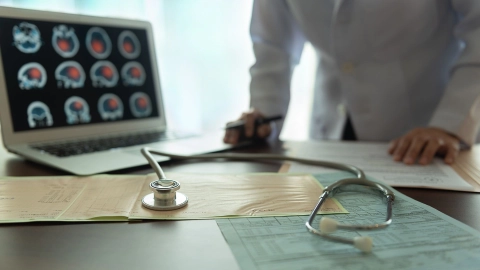Conditions Pulmonary embolism
ICD codes: I26 What are ICD codes?
A pulmonary embolism is caused by the blockage of a lung artery, after a blood clot from circulating blood has got into the lung. This is an emergency that requires urgent treatment.
At a glance
- A pulmonary embolism is when a blood vessel supplying blood to a lung gets blocked.
- The blockage is usually caused by a blood clot coming from the leg or pelvis.
- Typical symptoms include sudden breathlessness, chest pain, coughing up blood, dizziness, light-headedness and palpitations.
- A pulmonary embolism is an emergency and needs to be treated quickly. In the event of the above symptoms, the emergency services should be called immediately on 112.
Note: The information in this article cannot and should not replace a medical consultation and must not be used for self-diagnosis or treatment.

What is a pulmonary embolism?
A pulmonary embolism is caused by the blocking of a lung artery or its branches. This can occur when a larger blood clot from the body gets into the lung.
A pulmonary embolism has to be treated quickly because the blood flowing toward the heart can back up if a lung artery is blocked.
This can lead to excess strain on the heart and cause life-threatening heart failure.
Video What is pulmonary embolism?
The video below explains more about the symptoms, risk factors and treatment options for pulmonary embolism.
This and other videos can also be found on YouTube
Watch nowThe privacy policy indicated there applies.
How can a pulmonary embolism be identified?
If the blocked blood vessel in the lung is only small, there are no or only mild symptoms.
If the embolism occurs in larger vessels in the lung, the following symptoms may occur:
- sudden breathlessness
- chest pains, especially when inhaling or coughing
- coughing, especially when coughing up blood or together with other symptoms of a pulmonary embolism
- dizziness, numbness or fainting
- palpitations
- severe anxiety
Important: With these symptoms, immediate medical help is required. People experiencing these symptoms or their relatives should therefore always phone the emergency services on 112 and request an ambulance with an emergency doctor – not the on-call or stand-by GP service (“Ärztlicher Notdienst” or “Ärztlicher Bereitschaftsdienst”).
What happens with a pulmonary embolism?
If someone is injured and starts to bleed, the body tries to stop the bleeding quickly by sealing the wound with a blood clot.
This reaction by the body is critical. This keeps blood loss to a minimum, prevents germs from getting into the wound and helps the wound to heal.
Sometimes, however, a blood clot forms in the bloodstream without an external injury. If this blocks a blood vessel, it can result in dangerous complications such as a heart attack, stroke or pulmonary embolism.
This very rarely happens to a healthy person. But certain illnesses and genetic predispositions may increase the risk of a blood clot.
Blood clots that cause a pulmonary embolism can form in various areas of the body but mainly originate in the veins in the legs.
If a vessel is blocked by a blood clot, specialists refer to a thrombosis.
In the legs, clots often go unnoticed and disappear by themselves. However, some thromboses cause pain and swelling.
In rare cases, a blood clot in the leg can break loose and travel through the blood to the lung vessels, triggering an embolism.
In very rare cases, a pulmonary embolism can also be caused by fatty deposits, cellular components, air or amniotic fluid when giving birth.
What are the risk factors for a pulmonary embolism?
Because a pulmonary embolism most commonly occurs as a result of a thrombosis, the risk factors are similar.
The main risk factors are as follows:
- broken hip or leg
- major operations, for example the implantation of an artificial knee or hip joint
- blood clotting disorders, such as antiphospholipid syndrome
- a previous deep vein thrombosis
- certain cancers
- a heart disorder such as heart failure, heart attack or atrial fibrillation
- using hormonal contraceptives that contain estrogen (as in the case of most contraceptive pills)
- hormone therapy for menopause
Other risk factors, which on their own only slightly increase the risk of a pulmonary embolism, include:
- old age
- pregnancy
- obesity
- high blood pressure
- diabetes mellitus
- varicose veins
- more than three days of bed rest (immobility)
- infections of the lungs, for example with SARS-CoV-2
How common is a pulmonary embolism?
The risk of a pulmonary embolism increases with age: each year, the condition affects one in 1,000 people aged between 40 and 50 but about ten in 1,000 people aged 80 or above.
Men are generally affected more often than women.
How does a pulmonary embolism progress?
The way in which a pulmonary embolism progresses depends on the size and number of blood clots in the lung. The patient’s general health also plays a role, especially how well the heart and lungs are functioning.
In most cases, the heart manages to “pump against” blood clots that block blood vessels in the lung. If the heart is weakened, for example by an illness, it may be unable to pump enough blood into the lung, resulting in a drop in blood pressure.
If the body is no longer supplied with enough oxygen, a risk of circulatory failure ensues.
The blood pressure during a pulmonary embolism therefore acts as a good indication of how it is progressing. Of every 100 people with a pulmonary embolism:
- about 95 have a sufficient blood pressure and therefore a low overall risk of a severe or fatal outlook.
- about 5 have a blood pressure level that is far too low and therefore a high risk of a severe or fatal outlook.
In the event of persistent risk factors such as cancer or blood clotting disorders in particular, there is a risk of further embolisms.
How can a pulmonary embolism be prevented?
Following surgery or a prolonged period of relative immobility, medication can be used for several days or weeks to prevent blood clotting. This can be injected or taken orally.
For people who have been operated on or who are injured and have to spend several days in bed, it is also important to get up again as soon as possible and to move about.
Small exercises, such as foot wiggling are also recommended to keep the blood flowing.
People at a high risk of deep vein thrombosis (DVT) can wear anti-thrombosis stockings (compression stockings). These exert pressure on the legs through their tight fit, causing the blood to flow back to the heart more quickly.
People who take anticoagulants (anti-clotting medication) do not need medical compression stockings. They are an alternative for people who are unable to take anticoagulants.
For more detailed information on how to prevent further embolisms, please visit gesundheitsinformation.de.
How is a pulmonary embolism diagnosed?
Symptoms such as sudden chest pain or breathlessness can also have other causes, such as a heart attack or pneumonia.
In the event of these kind of symptoms, the emergency services should always be called on 112 so that the cause can be quickly determined.
If a pulmonary embolism is suspected, the doctor begins with detailed questioning and an examination. It is important to produce a reliable diagnosis as quickly as possible.
The hospital performs various successive, interrelated tests, which together enable a diagnosis. These include:
- a blood test (D-dimer test)
- an electrocardiogram ( ECG)
- an ultrasound scan of the heart and the veins in the legs or a scan of the lungs in the form of a computed tomography pulmonary angiogram (CTPA)
How is a pulmonary embolism treated?
Pulmonary embolism treatment primarily depends on whether the circulation is stable and the severity of the symptoms.
Treatment in the event of stable circulation
If the circulation is stable, patients often remain in hospital for a few days and are prescribed anti-clotting medication (anticoagulants).
This treatment is known as anticoagulation. The medication inhibits blood clotting and prevents the existing clot from growing or new blood clots from forming. The body can then gradually break down the existing blood clot.
Treatment in the event of unstable circulation
People whose circulation is unstable will be treated in intensive care from the outset and monitored. Several measures are used here to support their breathing and circulation, for example infusions, mechanical ventilation and supplementary medication. Treatment with anticoagulants also commences immediately – usually before the diagnosis has been completed.
If possible, an attempt is made to break up the blood clot through systemic thrombolysis. “Systemic” means that the treatment affects the entire body. To this end, special active substances are delivered to the body via an intravenous drip. This kind of thrombolysis is not an option if there is a high risk of bleeding.
Sometimes the embolism is then treated by means of an intervention using a catheter. A catheter is a thin, flexible tube that is pushed through the blood vessel as far as the blocked lung artery. Then it is attempted to break down the clot there. Drugs can also be delivered via a catheter to break down the blood clot in situ.
Treatment after recovering from a pulmonary embolism
Once a patient has recovered from a pulmonary embolism, doctors usually recommend several months of treatment with an anticoagulant. To prevent further thromboses, it can be useful to take anticoagulants for a prolonged period.
More detailed information about treating a pulmonary embolism with anticoagulants can be found at gesundheitsinformation.de.
- Crawford F, Andras A, Welch K et al. D-dimer test for excluding the diagnosis of pulmonary embolism. Cochrane Database Syst Rev. 2016 Aug 5;2016(8):CD010864. doi: 10.1002/14651858.CD010864.pub2.
- Deutsche Gesellschaft für Angiologie – Gesellschaft für Gefäßmedizin e.V. (DGA). Diagnostik und Therapie der Venenthrombose und der Lungenembolie. S2k-Leitlinie. AWMF-Registernummer 065-002. 10.2015.
- Duffett L, Castellucci LA, Forgie MA. Pulmonary embolism: update on management and controversies. BMJ. 2020 Aug 5;370:m2177. doi: 10.1136/bmj.m2177.
- Hao Q, Dong BR, Yue J et al. Thrombolytic therapy for pulmonary embolism. Cochrane Database Syst Rev 2018; (12): CD004437. Cochrane Database Syst Rev. 2018 Dec 18;12(12):CD004437. doi: 10.1002/14651858.CD004437.pub5.
- Izcovich A, Criniti JM, Popoff F et al. Thrombolytics for venous thromboembolic events: a systematic review with meta-analysis. Blood Adv. 2020 Apr 14;4(7):1539-1553. doi: 10.1182/bloodadvances.2020001513.
- Khatib R, Ross S, Kennedy SA et al. Home vs hospital treatment of low-risk venous thromboembolism: a systematic review and meta-analysis. Blood Adv. 2020 Feb 11;4(3):500-513. doi: 10.1182/bloodadvances.2019001223.
- Konstantinides SV, Meyer G, Becattini C et al. 2019 ESC Guidelines for the diagnosis and management of acute pulmonary embolism developed in collaboration with the European Respiratory Society (ERS). Eur Heart J. 2020 Jan 21;41(4):543-603. doi: 10.1093/eurheartj/ehz405.
- Maughan BC, Frueh L, McDonagh MS et al. Outpatient Treatment of Low-risk Pulmonary Embolism in the Era of Direct Oral Anticoagulants: A Systematic Review. Acad Emerg Med. 2021 Feb;28(2):226-239. doi: 10.1111/acem.14108.
- Ortel TL, Neumann I, Ageno W et al. American Society of Hematology 2020 guidelines for management of venous thromboembolism: treatment of deep vein thrombosis and pulmonary embolism. Blood Adv. 2020 Oct 13;4(19):4693-4738. doi: 10.1182/bloodadvances.2020001830.
- Pöss J, Freund A, Vollert JO et al. Lungenarterienembolie. Prozessorientierte und standardisierte Umsetzung der nationalen und internationalen Leitlinien. Kardiologe 2018; 12: 68–82.
- Pschyrembel Online. 2022.
- Robertson L, Kesteven P, McCaslin JE. Oral direct thrombin inhibitors or oral factor Xa inhibitors for the treatment of pulmonary embolism. Cochrane Database Syst Rev. 2015 Dec 4;2015(12):CD010957. doi: 10.1002/14651858.CD010957.pub2.
- Yoo HH, Nunes-Nogueira VS, Fortes Villas Boas PJ et al. Outpatient versus inpatient treatment for acute pulmonary embolism. Cochrane Database Syst Rev. 2019 Mar 6;3(3):CD010019. doi: 10.1002/14651858.CD010019.pub3.
- Young T, Sriram KB. Vena caval filters for the prevention of pulmonary embolism. Cochrane Database Syst Rev 2020; (10): CD006212. Cochrane Database Syst Rev. 2020 Oct 8;10(10):CD006212. doi: 10.1002/14651858.CD006212.pub5.
In cooperation with the Institute for Quality and Efficiency in Health Care (Institut für Qualität und Wirtschaftlichkeit im Gesundheitswesen) (IQWiG).
As at:





